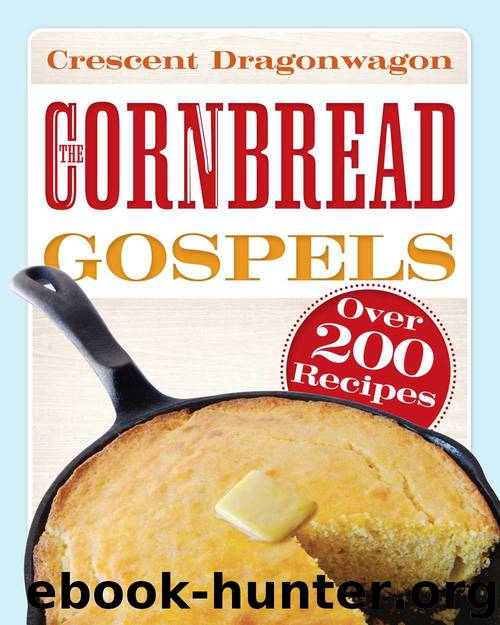The Cornbread Gospels by Dragonwagon Crescent

Author:Dragonwagon, Crescent [Dragonwagon, Crescent]
Language: eng
Format: epub
Publisher: Workman Publishing Company
Published: 2007-11-22T00:00:00+00:00
·M·E·N·U·
GUILFORD GARDEN SPOON SWOON
Sautéed Broccoli Rabe with Garlic and Olive Oil
*
Fresh Corn Spoonbread
*
Butternut Squash Chunks with Maple Syrup and a Squidge of Butter
*
Tomatoes Stuffed with Spinach and Parmesan
*
Ben & Jerry’s Coffee Heath Bar Crunch Ice Cream
*
Brownies
IN PRAISE OF PORRIDGE
As we think about corn and the way it has taken root the world over, we must pay our dues to another widespread way—beside cornbread—the primal ingredients of cornmeal, water, salt come together the world over. When not being cooked by dry heat (that is, being baked, whether on a griddle or in an oven), these same three ingredients are usually becoming porridge.
Depending on who’s doing the eating, the porridges—the thicker ones similar in texture to spoonbreads—are known by different names. Native Americans called them sagamite, samp, nassasump, and suppawn. (Thinner versions were sofkee, known in the Southwest as atole or pinole.) These were among the main corn dishes that the eastern colonists found Indians cooking and eating when they arrived. The colonists quickly imitated these thicker porridges, which became “mush” or, if sweetened, “hasty pudding” or “Indian pudding.”
Next corn began its triumphal journey around the world, often in the form of this porridge. The North Italian’s polenta; the Romanian’s mamaliga; the East African’s ugali; the South African’s mealie, nshima, or sadza; the West African’s fufu (which was usually composed of yam, manioc, and/or plantain, mixed with corn) or putu—all are the same, cornmeal cooked in water until as thick, in most cases, as mashed potatoes.
Everywhere corn mush took root, it served as a filling backdrop for whatever one might ladle upon it. This was often stews (across cultures, these stews usually contained greens and/or beans) and sauces (often either spicy-hot or tomato-based). The recipes in Great Go-Withs, pages 297–326, pay homage to these universal pairings. Top your spoonbread—porridge’s close cousin—with a mess of greens or a heap of beans, and dig in.
Download
This site does not store any files on its server. We only index and link to content provided by other sites. Please contact the content providers to delete copyright contents if any and email us, we'll remove relevant links or contents immediately.
Biscuits: A Savor the South Cookbook by Belinda Ellis(4221)
A Jewish Baker's Pastry Secrets: Recipes from a New York Baking Legend for Strudel, Stollen, Danishes, Puff Pastry, and More by George Greenstein(3463)
Al Roker's Hassle-Free Holiday Cookbook by Al Roker(3436)
Ottolenghi Simple by Yotam Ottolenghi(3435)
The French Women Don't Get Fat Cookbook by Mireille Guiliano(3429)
Better Homes and Gardens New Cookbook by Better Homes & Gardens(3381)
Trullo by Tim Siadatan(3313)
Bake with Anna Olson by Anna Olson(3289)
Hot Thai Kitchen by Pailin Chongchitnant(3224)
Panini by Carlo Middione(3173)
Nigella Bites (Nigella Collection) by Nigella Lawson(3106)
Momofuku by David Chang(3059)
Modern French Pastry: Innovative Techniques, Tools and Design by Cheryl Wakerhauser(3033)
Salt, Fat, Acid, Heat: Mastering the Elements of Good Cooking by Nosrat Samin(3008)
Best of Jane Grigson by Jane Grigson(2880)
Tapas Revolution by Omar Allibhoy(2860)
Classic by Mary Berry(2846)
Solo Food by Janneke Vreugdenhil(2832)
The Club by A.L. Brooks(2758)
